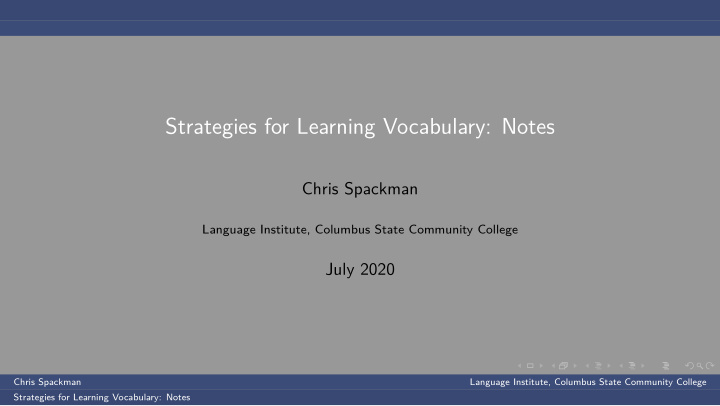



Strategies for Learning Vocabulary: Notes Chris Spackman Language Institute, Columbus State Community College July 2020 Chris Spackman Language Institute, Columbus State Community College Strategies for Learning Vocabulary: Notes
How Big Is Your Vocabulary? You checked your vocabulary. Maybe it is big, maybe small. It doesn’t matter. We are here to learn how to make it bigger . Chris Spackman Language Institute, Columbus State Community College Strategies for Learning Vocabulary: Notes
Learning Vocabulary Please answer these questions, briefly. We will all answer. I will call on students. We will think for a minute before starting to answer. Please make notes, if you want to. 1 Where do you find new vocabulary words? 2 How often do you use vocabulary cards? Everyday? Once a week? Never? 3 What software do you use to learn vocabulary? 4 Do you know and use “prefixes” and “suffixes”? Chris Spackman Language Institute, Columbus State Community College Strategies for Learning Vocabulary: Notes
Types of “Remembering” We will talk about two types of “remembering”: “recognition” and “recall”. Recognition You understand a word when you hear it or see it. This is your “passive vocabulary”. Recall You can think of a word that you need without hearing it or seeing it. This is not as easy as recognition. This is your “active vocabulary” — the words you know and can use. When learning new vocabulary, you want to move words: unknown → can recognize → can use (recall) . Chris Spackman Language Institute, Columbus State Community College Strategies for Learning Vocabulary: Notes
Strategy 0: Vocabulary Cards “Strategy zero” because it is very important. You should be using vocabulary cards even if you don’t use any of the other strategies we talk about today. But, please also use the other strategies! new vocabulary word on one side meaning, in native language (L1) or English on the other side → you can also have examples on the other side Chris Spackman Language Institute, Columbus State Community College Strategies for Learning Vocabulary: Notes
Strategy 1: Start with the definition If you use L1 words step 1: look at the English word and trying to recall L1 word after you can do that, then switch to . . . step 2: look at the L1 word and try to recall the English word If you use English definitions step 1: look at the definitions and try to recall the word after you can do that, then switch to . . . step 2: look at the word and trying to recall the definition Chris Spackman Language Institute, Columbus State Community College Strategies for Learning Vocabulary: Notes
Strategy 1: Start with the definition (continued) Basic vocabulary word routine: study about 15 words (your “deck”) for each step 2 word: easy, medium, or difficult? → easy set aside (your “done pile”); add new word card to your deck → medium keep in the deck → hard keep in the deck Chris Spackman Language Institute, Columbus State Community College Strategies for Learning Vocabulary: Notes
Strategy 2: “Spaced Repetition” “Spaced repetition” is the best way to learn new words ( Below is a very simple example of spaced repetition ) study the words in your deck as usual review the words in your “done pile” using spaced repetition: → one day later: know it? Leave in done pile. Don’t know it? Put in deck. → one week later: know it? Leave in done pile. Don’t know it? Put in deck. → two weeks later: know it? Leave in done pile. Don’t know it? Put in deck. → one month later: know it? Leave in done pile. Don’t know it? Put in deck. Computer software (“apps”) make it much easier to do spaced repetition. Chris Spackman Language Institute, Columbus State Community College Strategies for Learning Vocabulary: Notes
Strategy 3: Use the words in sentences See the word in use: usage examples in dictionaries and at dictionary web sites → Learner’s Dictionary https://www.learnersdictionary.com → Longman Dictionary of American English https://www.ldoceonline.com search for the word on news websites → Breaking News English https://breakingnewsenglish.com → CNN https://www.cnn.com → Voice of America https://www.voanews.com Chris Spackman Language Institute, Columbus State Community College Strategies for Learning Vocabulary: Notes
Strategy 4: Learn prefixes and suffixes If you know the word “do”, you can easily learn several new words by using prefixes and suffixes. For example: re do — to do again un do — to change back to how it was before do able — it can be done un do able — it cannot be done Chris Spackman Language Institute, Columbus State Community College Strategies for Learning Vocabulary: Notes
Practice Next, we will do some practice with Quizlet. Please go to: https://quizlet.com/515385261/ cscc-strategies-for-learning-vocabulary-flash-cards/ Chris Spackman Language Institute, Columbus State Community College Strategies for Learning Vocabulary: Notes
Apps and Software For most people, Quizlet is good enough. If you want more, start with Anki . Anki (for MS Windows, Mac OSX, & Linux) https://apps.ankiweb.net/ Anki Droid (for Android phones & tablets) https://play.google.com/store/apps/details?id=com.ichi2.anki&hl=en Anki Web (web — can link to your Anki app) https://ankiweb.net/about Chris Spackman Language Institute, Columbus State Community College Strategies for Learning Vocabulary: Notes
Recommend
More recommend